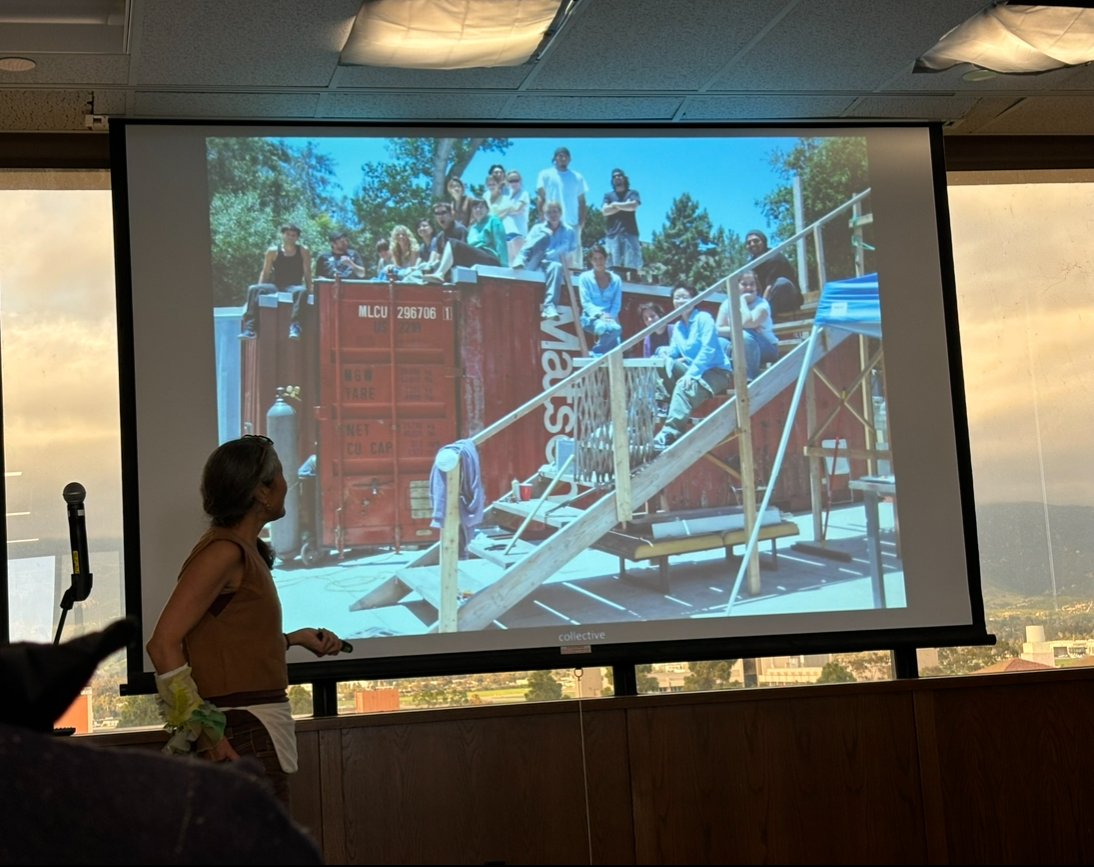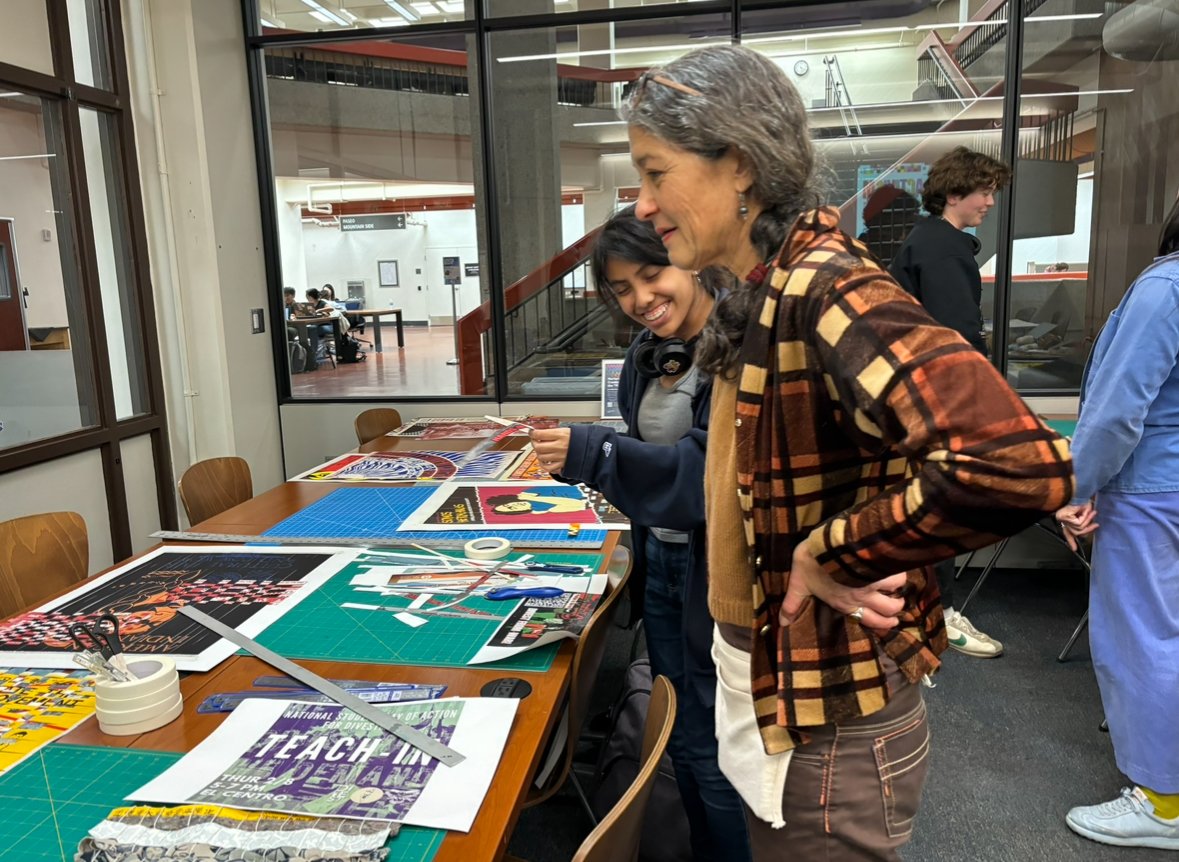By Zuri Wilson
Kim Yasuda, a professor in UC Santa Barbara’s Art Department, has spent a career redefining what it means to be an artist, with projects that focus on interacting with the public and which explore the intersection between academic and public life.
UCSB Art professor and public artist Kim Yasuda gave the talk “Public Art and Campus Placemaking: Recentering the Artist in Communities of Practice,” about her 30-year, interdisciplinary career. The event was part of the UCSB Library speakers series “Pacific Views.“
Yasuda recently spoke about her work in architecture, public art, and collaborative community projects in Santa Barbara and across the state in a lecture titled “Public Art and Campus Placemaking: Recentering the Artist in Communities of Practice.” She said the arts provide untapped potential for interdisciplinary exchange and cultural advocacy amongst students, scholars, and the wider public.
“Art is part of a kind of collective,” she said. “I make work with others and we share ownership. We share authorship. The projects I did in Isla Vista were not only me. I was one of many players.”
Yasuda’s presentation was part of the second Pacific Views: Library Speaker Series, one of several events tied to the UCSB Reads 2024 book “Your Brain on Art: How the Arts Transform Us,” by Susan Magsamen and Ivy Ross. UCSB Reads brings the campus and Santa Barbara community together each year to read a common book that explores compelling contemporary themes.
Yasuda had suggested this book in order to spark a discussion on the important role art plays in our lives, both inside and outside of the classroom. Since she first started teaching at UCSB in 1992, Yasuda has worked with faculty in the Division of Humanities and Fine Arts and across the campus. She worked with the Black Student Union and Chicanx students on campus to open the Isla Vista Community Center in 2019 that provides support and resources to students. Yasuda and her students also have collaborated with Jeffrey Stewart, UCSB’s vice chancellor of diversity, equity and inclusion, to design an alternative classroom environment for his history of jazz course, and to create a new jazz club using public venues and cafés in downtown Santa Barbara.
Art professor Kim Yasuda presented examples of her former students’ work at her library talk entitled “Public Art and Campus Placemaking: Recentering the Artist in Communities of Practice.”
“My work tries to reimagine the institution as part of my material practice, shaped by culture, social encounter and exchange,” Yasuda said in a recent interview. “It’s not just having arts programming on a campus, it’s when you have artists who activate the campus.”
Yasuda’s library talk covered 30 years of work and 300 images in only 30 minutes. “[My colleague] advised me to show three projects,” Yasuda said jokingly. “So, I decided to go in the opposite direction.”
She showcased student-led art projects that have re-shaped academic and artistic environments. In an older project from 2005, Yasuda and her students worked with local contractors, architects, and residents to convert shipping containers into fully functional dwelling units to help with the Santa Barbara housing crisis – which has only worsened with time. “If you make spaces for creativity and active engagement, you propagate a creative ecology,” Yasuda said. “Looking back, we created something that was bigger than all of us.”
She also showed pictures of undergraduate art students who took the lead in creating a memorial to victims of the 2014 Isla Vista mass shooting tragedy. Yasuda and her students worked with the Media, Arts, and Technology (MAT) program to illuminate the site at the Pardall tunnel between campus and neighboring Isla Vista. A year after the shooting, approximately 1,000 students gathered at that memorial to remember the six students who lost their lives in the tragedy.
Alex Regan, events and exhibition librarian at UCSB, said Yasuda’s work fulfills the vision of current Humanities and Fine Arts division Dean Daina Berry, who wishes to see artists enter the public realm and become more visible.
Art professor Kim Yasuda’s recent lecture focused on advocacy and interdisciplinary collaboration. Also as part of UCSB Reads 2024, she went to an affiliated poster-making event after giving her talk.
“Kim has worked with campus faculty, students and staff across arts and humanities, social sciences, and STEM,” Regan said. “She has built coalition and cross-sector collaborations that mitigate social and environmental challenges.”
Yasuda created a “Friday Academy” in order to bring students and faculty across different fields together. “It doesn’t matter what the schedule is, it doesn’t matter how long it takes. At the Friday Academy we do project-based research and anybody’s welcome,” she said.
Yasuda says her art activism stems from a desire to connect art, academic stewardship, and public participation. She describes herself as a “make-it-happen person,” who offers students tools and resources to activate their vision and support the next generation of artists.
One recent projects that she directs, The Arts Equity Commons, is a $175,000 faculty diversity grant from the UC Office of the President, that places artists in and around university spaces. This initiative invites artists-in-residence, such as Texas-based Vietnamese American artist Tiffany Chung, to work with a diverse cohort of faculty, students and staff on campus. Chung will develop artwork with students in art, media and dance, that will be exhibited at the Art Design and Architecture Museum in Fall of 2025.
As part of Kim Yadsuda’s initiative, The Arts Equity Commons, artist in residence Elena Yu led a poster-making workshop in conjunction with the UCSB Reads 2024 pick, “Your Brain on Art: How the Arts Transform Us,” by Susan Magsamen and Ivy Ross.
This year’s artist-in-residence, Elena Yu, led a paper-weaving workshop in the Library’s second floor Ethnic Studies area after Yasuda’s presentation, using old posters that show student activism from the 1960s to the present. This event also shone a light on the library’s California Ethnic Studies and Multicultural Archives, which Yasuda said most students don’t know about.
Yasuda says art is often viewed as an extracurricular or a non-essential hobby at a research institution, but doing what you love at UCSB and supporting others through art is a privilege that “becomes a seed for a different future.”
Though Yasuda will be retiring at the end of this school year, she has no plans to stop her public artwork any time soon and she hopes to support students find success post graduation. “I think that’s the saddest thing when somebody has spent four years invested in their art career or masters and then can’t find a good viable job,” she reflected.
Yasuda says her interactive approach to art differs from “traditional” art forms that are produced in a studio and presented in exhibitions. She describes herself as a “public artist” with a focus on collaborative, rather than individual, involvement in the community and the world at large.
“Public art is about a collective voice rather than individual solo voice,” Yasuda explained. “My studio is the public realm.”
Zuri Wilson is a third year Film and Media studies and Black Studies double major. She covered this event and conducted this interview for her Digital Journalism course.





